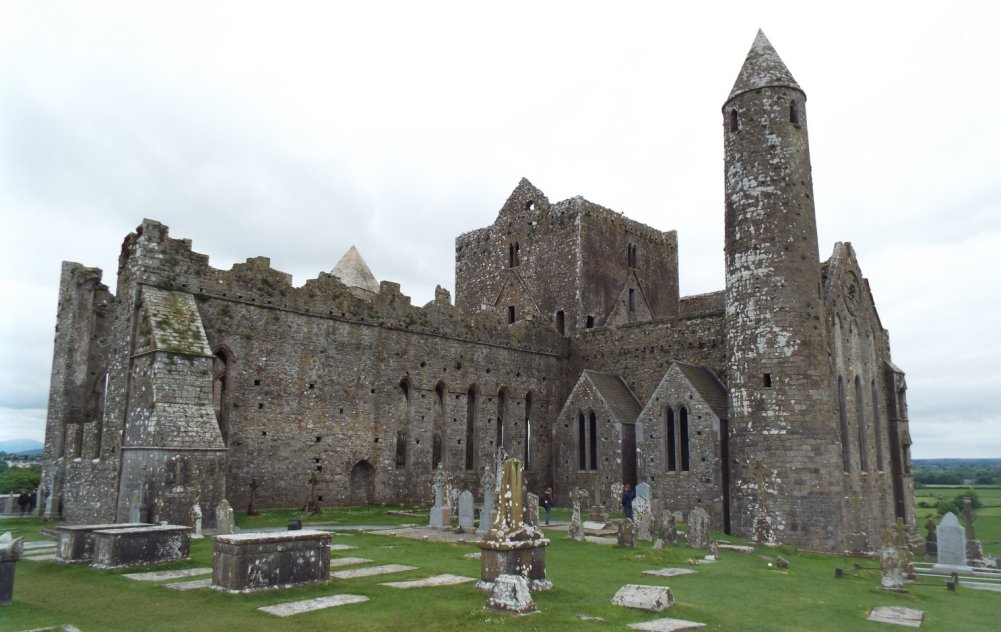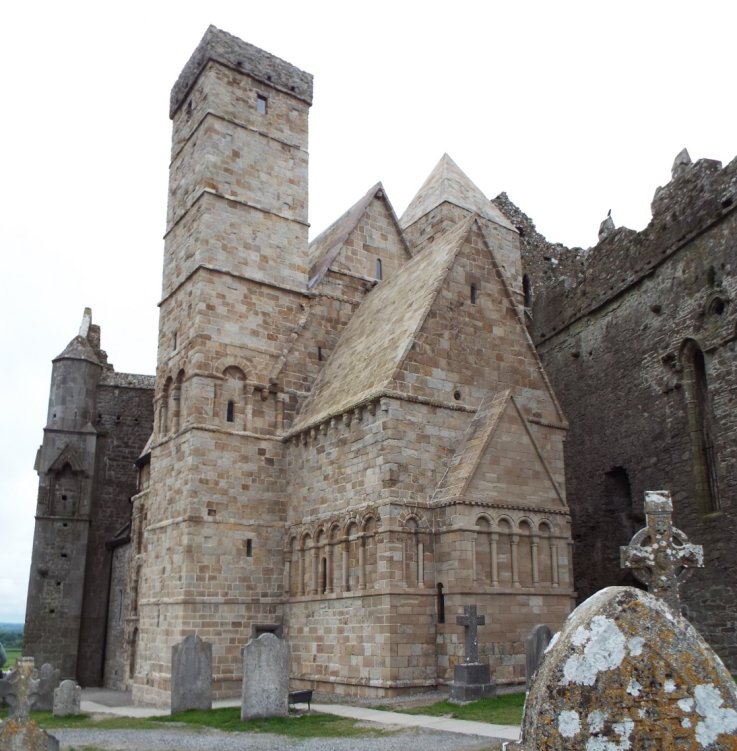THE ROCK OF CASHEL

Allegedly the Rock of Cashel came from the Devil's Bit, a
mountain 20 miles north of Cashel. This occurred when St Patrick
banished Satan from a cave, resulting in the Rock landing in
Cashel. Similarly Cashel is reputed to be the site of the
conversion of the king of Munster by St Patrick in the fifth century.
In history the Rock of Cashel was the traditional seat of the kings of
Munster from the fifth century. In 903 Cormac MacCuileannan was
called king of Cashel when he was slain. He was also described as
king, bishop, anchorite and scribe, the first 2, no doubt, being in
relation to Cashel. In 939 it was called ‘beautiful
chalk-white Caiseal'. Later Cashel saw the crowning of King Brian
Boru of Ireland in 977, while in 1030 the implication of a comment at
the death of King Brian's widow, Gormlaith, indicates that she had
resided at Cashel (Caiseal).
By 1090 Muirchertach O'Brian (d.1119), the great grandson of King
Brian, was recognised as king of Cashel. In 1091 the site was
described as a house when:
Lord Cinaeth O'Mordha of
Laeighis and the son of Maelruanaidh, son of Cucoirne, mutually fell by
each other in the house of O'Brian at Caiseal.
In 1101 Muirchertach gave his fortress on the Rock to the Church.
A meeting of Leath-Mogha was
held at Cashel by Muirchertach O'Brian, with the chiefs of the laity
and... with the chiefs of the clergy; and on this occasion Muirchertach
made a grant such as no king had ever made before, namely, he granted
Cashel of the kings to the religious, without any claim of layman or
clergyman upon it, but the religious of Ireland in general.
At this time it is claimed that the round tower of 90' was built.
However, Cashel may have been out of O'Brian control probably since the
death of Muiredach MacCarthy in 1092 when Caellachan O'Callaghan was
given the designation ‘of Cashel' when he killed Muiredach's
brother and successor. The grant of Cashel may therefore have
been speculative. In any case Cashel was recorded as burned by
lightning in 1107.

Caellachan of Cashel was killed in 1115 and it was probably only then
that King Tadhg MacCarthy of Desmond seized the Rock and died there
after making penance in 1124. He was succeeded by his brother,
Cormac MacCarthy (d.1138). Early in 1127, Cormac had been
defeated by Turlough O'Connor (d.1156), deposed and replaced by his
brother, Donnchad MacCarthy (d.1143). With this Cormac was
tonsured and retired to Lismore abbey. Donnchad surrendered to
O'Connor after a brief siege of Cork on 1 February (St Bridget's day)
1127. Despite this defeat Cormac was then taken from Lismore and
given the kingship of Munster by Connor O'Brian, who, according to
St Bernard, was filled with wrath at what had been done to
Cormac. The allies then moved on Desmond and again according to
St Bernard ‘the marauders were driven out with ease and
[Cormac]... was led back to this own with great rejoicing of his
people'. Donnchad was then expelled to Connaught with 2,000 of
his followers. After a war against O'Connor, which resulted in
the destruction of Galway and Athlone
castles, MacCarthy ruled supreme in the south of Ireland. In 1131
the death of an archbishop of Cashel was recorded. In 1134:
A church which was erected by
Cormac, grandson of King Carthach of Cashel, was consecrated by a synod
of the clergy assembled in one place.
This is claimed to have marked the completion of the so-called Cormac's
chapel. Cormac himself was finally killed at his own house of
Mahoonagh, Co. Limerick, in 1138. He was succeeded by his
brother, Donnchad (d.1143). Ormond with Cashel meanwhile passed
under the control of first Olaf (d.1164) and then Domnall O'Kennedy
(d.1181), who eventually styled themselves lords of Ormond.
Meanwhile Cashel was declared an archbishopric at the synod of Kells in
1152 and Archbishop Domhnall of Cashel died in 1158. The Fitz
Walter/Butler family of Nenagh took over the
district sometime, probably in the late twelfth century. By 1172 Cashel was held by King Domhnall O'Brian of Limerick (Lymricii, d.1194) when he became King Henry II's man, while the next year a synod was held on the Rock to reform the Irish church.
Despite the historical record, there is no
evidence as to when the cathedral was built, but architects claim it
was built between 1235 and 1270, and therefore presumably under the
auspices of archbishops Marian O'Brian (1224-38), David MacKelly
(1238-53) and David MacCarwell (1254-89). Similar to nearby Hore
abbey and the Dominican friary, the cathedral was much altered in the
fifteenth century. Parapets were added and the west end converted
into the towerhouse, possibly for Archbishop Richard O'Hedian
(1406-40). This possibly occurred simultaneously with Archbishop
Richard endowing the Vicars Choral with lands and building the hall for
them with accommodation on the south side of the rock.
In 1647, during the Irish Confederate Wars, Cashel was sacked by
English Parliamentarian troops under Earl Murrough O'Brian of
Inchiquin, who massacred the Irish Confederate troops there as well as
the Roman Catholic clergy, including Theobald Stapleton.
Subsequently in 1749, the main cathedral roof was removed by Arthur
Price, the Anglican archbishop of Cashel, who transferred his seat to
St John's church in the town. By 1848 the rest of the cathedral
roof had collapsed as had the south side of the towerhouse and the east
gable of the choir.
Excavation works in 1992
and 1993 showed that the site had a
long history. The conclusion was that the standing remains
represent
two of the six churches that once stood on the site.
Historically
churches are recorded in 1111, 1127, 1169 and the thirteenth century.
The first date, 1111, is when the early church was dedicated
a
cathedral at the Synod of Rathbreasail. It has been suggested
that
this was built soon after the rock was handed over to the church by King
Muirchertach O'Brian (d.1119) in 1101. Although this is assuming
that a dedication
must occur after building and not simply after some sacriledge or
rebuilding has occurred at the site. The second date of 1127 is
when
Cormac's chapel
was started, the third, 1169, when the Romanesque cathedral was begun
and 1235 when the Gothic cathedral was commenced. The excavations
recovered a wooden church under the nave of 'Cormac's chapel', a stone
church under the wall of the current cathedral and then the 3 churches
as mentioned above as well as the Gothic cathedral.
The excavators deduced that a wooden church stood on the site prior to
1101 and that graveyard deposits hinted at occupation on the rock going
back to the sixth century AD. It seemed that the first wooden
church was abandoned a long time before the first stone church was
built as its graveyard cut through the site of the wooden
structure. Presumably there was no longer any trace of the
building for this to happen. The tentative conclusion was
therefore an initial possibly secular use of the site between the sixth
and ninth centuries. Around the tenth or eleventh century a stone
church was built with its graveyard over the site of the wooden
church. This was followed by the building of the so-called
Cormac's chapel next to the earlier stone church under the current
cathedral. No certain dateable archaeological features were
found, so all these suggestions are merely tentative. Indeed it
was suggested that the early wooden church might have been of 2 phases
itself. Further, even its plan remains uncertain.
What the excavation did clearly show was that there was an apparent
division of the rock into an eastern and western half before the
building of 'Cormac's chapel'. It would seem that religious
activity was confined to the eastern portion at this time.
Finally it is worth pointing out that the so-called 'Cormac's chapel'
has no secure dating evidence and in style it is far nearer to
'Anglo-Saxon' churches in England, viz. Bradford on Avon in Wiltshire than to any twelfth century structure.
Why not join me at Cashel
and other Irish castles this October? Please see the
information on tours at Scholarly
Sojourns.
Copyright©2017
Paul Martin Remfry


